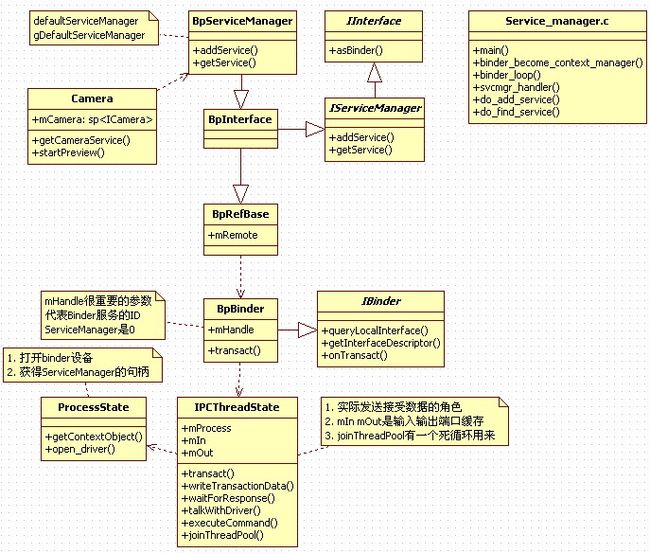Android - Binder机制 - 获得普通service
以下几篇文章是较深入分析binder机制。
目录
1. Android - Binder机制 - ServiceManager
2. Android - Binder机制 - 普通service注册
3. Android - Binder机制 - 获得普通service
4. Android - Binder机制 - client和普通service交互
5. Android - Binder机制 - Binder框架总结
6. Android - Binder机制 - ProcessState和IPCThreadState
7. Android - Binder机制 - 驱动
UML及说明
1. Camera是客户端进程,它有一个函数是getCameraService函数,该函数就要获得CameraService服务;
2. Service_manager.c就是第一篇将的ServiceManager,它是另外一个进程,它要通过binder接收该进程的GetService请求,并进行相应处理(第一篇已经讲);
3. IInterface和IServiceManager定义了Camera和ServiceManager之间的功能接口,它是一个抽象类;
4. BpServiceManager和BpInterface继承于IServiceManager,当然就是对功能接口的具体实现;
5. Camera调用BpServiceManager的getService()接口获得服务;
6. IBinder是定义Binder数据传输层的功能接口,它有一个接口transact,做过android的应该都有印象,它也是一个抽象类;
7. BpBinder是对IBinder的具体实现,它是用来进行数据传输的,BpRefBase中的mRemote就是指向的BpBinder,BpRefBase起了一个代理作用,但是BpBinder没有直接和binder打交道,而是通过调用下面的IPCThreadState实现的;
8. IPCThreadState才是和binder进行打交道的类,它才是真正的数据传输者;
9. ProcessState它主要打开binder设备供IPCThreadState使用和获得ServiceManager用来注册服务;
10. 在分析的时候还是先有一个整体把握,这个会在后面详解,BpRefBase以上是业务逻辑(要实现什么功能),BpRefBase以下是数据传输(通过binder如何将功能实现);
11. 以后只要是见到Bpxxx的是在client进程,Bnxxx的是在service进程;
获得服务
1. 通过defaultServiceManager获得BpServiceManager,通过BpServiceManager的getService接口;
2. getService执行remote()->transact(CHECK_SERVICE_TRANSACTION, data, &reply);
3. remote()其实是BpBinder,transact执行IPCThreadState::self()->transact(mHandle, code, data, reply, flags),注意mHandle是0,代表ServiceManager;
4. IPCThreadState::self()->transact执行writeTransactionData(BC_TRANSACTION, flags, handle, code, data, NULL)和waitForResponse(reply),很明显就是发送数据,然后等待响应;
5. writeTransactionData其实并不直接将数据发送到binder驱动,而是将数据写到了mOut缓冲区,mOut是Parcel,该类是封装和驱动交互数据的数据格式(如果精通binder,要清楚这个格式);
6. waitForResponse调用talkWithDriver()获得binder的答复;
7. reply.readStrongBinder(),在Parcel中,binder是一个数据类型,所以readStrongBinder函数可以将reply转为IBinder,而且是BpBinder,其中的mHandle就是刚获得service的handle索引;
